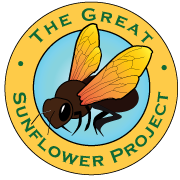Welcome to the Great Sunflower Project!
We are delighted to have you join us and hope that you’ll become part of our community of gardeners, beekeepers, birders and naturalists who are providing thousands of records of pollinators each year. Your records are invaluable data on the state of our pollinators and are helping to build the best data set on plants and pollinators.
The best and most useful way to contribute to the Great Sunflower is to focus on a particular site or set of sites. Each time you visit your yard, favorite park or wild area, you can do a pollinator count on any of the plants in that space. Over time, this will be a record of the health of your pollinator community.
How to count pollinators when doing a stationary count.
-
Start by recording the date, time and where you are.
-
Then, choose a plant to watch and write down what type of plant it is (either a common name or scientific name).
-
On that plant, decide how many flowers you are going to watch and write that down.
-
If it is a plant with lots of flowers in a spike or bunch, you will need to count how many flowers are in that bunch.
-
-
-
Once you are settled, start your timer and record the number of visits by pollinators
-
If possible, write down the type of pollinator. You can be as specific as you want but please only be specific if you are certain!
-
If a pollinator goes away and comes right back, count it twice or as many times as needed. We are interested in the number of visits rather than the actual number of pollinators.
-
-
When you are done (try to do at least 5 minutes), enter the data at the website, www.GreatSunflower.org. Start by logging in at the website and then click on Add a Count.
-
Step 1
-
The initial page will ask what type of count you did, answer ‘Stationary’
-
Choose an observation time (If you are on a smart gadget or computer, we actually have a built in timer so you can do this all on your gadget!)
-
Identify where you were, either by selecting a previous location or identifying a new location on a map.
-
Click Next
-
-
Step 2
-
Enter the number of flowers
-
Enter the type of plant (this is a smart box that will give you some choices)
-
Click Next
-
-
Step 3
-
Enter what you saw using the bright green buttons.
-
If you saw more than one species of a particular type of pollinator, you will want to use the “I saw another pollinator” link.
-
If you saw no pollinators, please be sure to check the box. These are the MOST important data that we get.
-
-
Click Next
-
-
Step 4
-
Enter the number of minutes that you spent observing your flower.
-
Click Finish!
-
You can then edit anything that was incorrect on the next screen.
-
-
